The surgeon who put my child’s G tube in was: Dr._______________________________
My child’s tube was inserted for the first time on:_______________________________
My child’s sutures should be removed on:_______________________________
My child’s tube was last changed on:_______________________________
My child’s tube is a (circle one): Mic G / Foley / Malecot / Pezzer / Low profile button
My child’s tube size is: _______ FR
There is ____ mL of water in the balloon of my child’s tube
The external measurement of my child’s tube is:____________ cm
| The SickKids G-Tube Feeding Program has developed a one page guide to help you quickly troubleshoot any issues with your child's feeding tube: G-Tube Feeding Program Family One Pager |
What is a surgical G tube?
A gastrostomy (G) tube is a feeding device that gives liquid nutrition, medication and other fluids directly into the stomach. The hole where the tube goes into the stomach is called a stoma. The tunnel from the outside into the stomach is called the tract.
Surgical G tubes are inserted by a general surgeon in an operating room. There are several reasons why your child may require a surgical feeding tube. If your child already has a surgery scheduled, or if insertion cannot technically be done by the interventional radiologist, then the tube will be surgically inserted in an operating room by a surgeon.
Your child will have a general anaesthetic during the procedure. After the tube is inserted, your child will stay in the hospital for several days or more, depending on their condition.
Sutures
All surgically inserted G tubes will be sutured (stitched) to the abdomen. These sutures (stitches) keep the tube secured to your child’s skin so it does not fall out accidentally. The stitches are non-dissolvable. Talk to your child’s general surgery team about when the stitches will be removed from the skin. The stitches are usually removed by the surgeon or G tube team when your child has their first tube change after 8 weeks. However, the stitches may detach from the skin on their own at home before the 8-week tube change. When this happens, some of the stitch string may be left wrapped around the tube. Do not remove the stitches from your child’s skin or from around the tube on your own; the surgeon or G tube team will do this.
Dressing
After primary insertion, your child will have a dressing over the skin and tube to prevent it from falling out accidentally. It may or may not have gauze at the site.
Types of surgically inserted G tubes
Pezzer or Malecot
Pezzer or Malecot G tubes are latex containing and are used mainly for very small babies and after specific procedures. These tubes have a "mushroom" type end which, along with the stitches and dressing, will help prevent the tube from being pulled out.
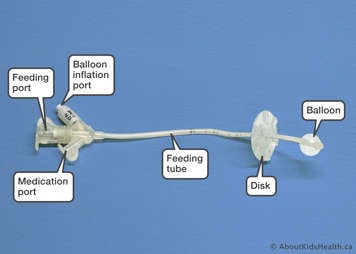
Mic Gastrostomy (Mic G)
Mic G tubes have an inflated balloon on the inside of the stomach to prevent the tube from being pulled out. They also have a disk that sits on the outside of the abdomen, to prevent the tube from sliding farther into the stomach. The disk will sit close to the stoma and, initially, will have stitches to prevent the tube from accidentally falling out.
When the tube is first inserted, ask your child’s surgeon if they inflated the balloon, and if so, with how much water. There is no need to tape the Mic G to the skin once the stitches are gone. If the disk is too tight, it may rub against your child’s skin, which can cause skin problems. If this happens, once the stitches are removed, you may adjust the position of the disk by sliding it up or down, closer or farther from the stoma.
Foley catheter type tube
Foley catheter type tubes have a balloon on the end of the tube to prevent the tube from being pulled out. They have a balloon port on the other end to allow you to add and remove water from the balloon, as well as an opening to give feeds and medications through. When the tube is first inserted, there will be stitches around the tube and in the skin to prevent the tube from accidentally falling out. After the stitches are gone, the Foley will need to be taped to the abdomen at all. Foley catheter type tubes should be coiled under a clear dressing.
Ask your child’s surgeon if they inflated the balloon, and if so, with how much water.
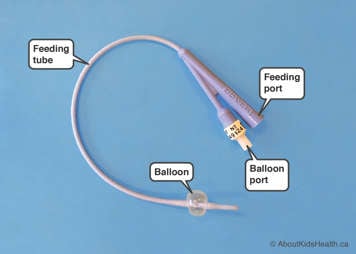



Low profile "button" tubes
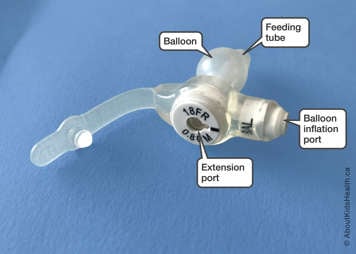
Some hospitals surgically insert a low-profile G tube, such as a Mic-Key.
The low-profile tube has an inflated balloon on the inside of the stomach to prevent the tube from being pulled out. Ask your child’s surgeon if they inflated the balloon, and if so, with how much water.
Low-profile tubes are usually inserted as a secondary tube, after an initial tube has been in place for at least 8 weeks.
Change the dressing and clean your child’s skin with soap and water once per week. Dressings typically stay on for 6-8 weeks until the stitches are removed.
Securing the tube once the sutures are removed
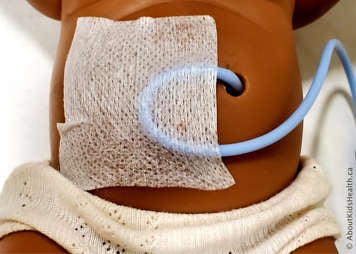
For all tube types, before securing the tube, always pull gently on the tube until you feel resistance of the balloon against the stomach wall.
If your child has a Foley catheter type tube, it must always be taped to the abdomen to prevent it from being pulled out. If your child pulls at their tube, you may coil the tube slightly to prevent dislodgement. The stoma should be open to the air.
For Foley catheter type tubes, you will also need to rotate the position of the tube daily to prevent stoma issues. Pretending the stoma is a clock, move the tube "1 hour" every day. For example, move the tube from 12 o’clock to 1 o’clock, then the next day to 2 o’clock and so forth.
Making sure the tube is in the correct position
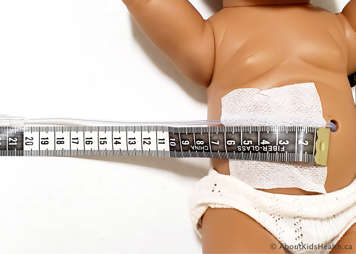
Measure the length of the G tube outside of the stomach so that you will be able to tell if the tube has moved farther in or out of the stomach.
If your child has a Mic G tube, use the securement disk to ensure the tube stays in the correct position.

With Foley catheter type tubes, measure the length of the tube outside your child’s stomach - from the stoma to the end of the top of the tube. With the Mic G, look at the cm marking on the tube. This helps you to know if the tube has accidentally moved further into the stomach than usual. Mark this measurement on the area provided at the beginning of this handout. Measure the length of the tube every day.
Balloons
Most surgically inserted G tubes have a balloon on the end that sits inside the stomach to prevent the tube from being accidentally pulled out. The balloon is inflated with sterile or distilled water. The amount of water you insert into the balloon will vary based on what your surgeon recommends – write this information in the area provided in this handout. Keep it somewhere easily accessible, such as on your phone or posted on the fridge.
The surgeon who inserts the tube may fill the balloon with less than the recommended balloon volume. If this is the case, you will need guidance from your health-care team before you increase the balloon volume.
Checking the balloon
To make sure the balloon on the end of the tube is not damaged, which can lead to the tube being pulled out, you must check the volume of water in the balloon at least once a week, starting once the tube has been in place for more than 8 weeks after primary insertion.
Don’t be alarmed if there is no water left in the balloon when you check for the first time – this is normal.
How to check the balloon:
- Insert a slip tip syringe into the balloon port. On the Mic G, the balloon port says "BAL". On the Foley catheter type tube, the balloon port is the one with the hard, white plastic.
- Remove all the water from the balloon. Throw the old water away. You may notice this water is discolored. This is normal.
- Re-inflate the balloon with the same amount of new sterile or distilled water you normally use.
Important notes about checking the balloon:
It is normal for less water to be removed from the balloon than what you put in, due to evaporation. There could be up to 0.5 mL less water. If there is a difference of more than 0.5 mL of water from what you put in and what you remove, the balloon may be damaged, and the tube may need to be replaced.
If you do not get any water back when checking the balloon:
- Re-inflate the balloon with the amount of water you normally put in.
- After three to four hours, attempt to withdraw this water. If you get all the water back, the balloon may have originally been empty. You can then re-inflate the balloon with the amount of water recommended by your surgeon. Check the balloon volume every two to three days to be sure there are no further problems.
- If you do not get any water back when you withdraw after three to four hours, the balloon is likely damaged and the tube will need to be replaced.
Even if the balloon is broken, the tube is still in the stomach and you may still use the tube for feeding and medications. However, when the balloon is broken, there is a risk the tube might fall out. Tape the tube to the abdomen until you can change the G tube.
There is no need to go to the emergency department if the balloon is broken.
For more information on Balloon G tubes, please see the article "Balloon G tubes".
Changing your child’s feeding tube for the first time
In some cases, your child’s surgeon will be the first person to change the tube.
In most cases, after 8 weeks your child’s Mic G or Foley catheter type tube can be changed to a low-profile G tube, such as an AMT miniONE or Mic-Key button.
If your child has a tube that is smaller than size 12FR, their surgeon will need to stretch the stoma to make it bigger until it is 12FR. Then it can be changed to a low-profile G tube. The low-profile G tube insertion is done in clinic with a G tube specialist (at SickKids, this is the G tube resource nurse).
What to do if the feeding tube is accidentally pulled out
You must always have an emergency kit available, wherever you go. An emergency kit includes:
- a back-up G tube or Foley catheter type tube
- lubricant
- syringes
- sterile or distilled water
- pH strips and colour reference guide
- tape
If your child’s tube has been in for less than 8 weeks
If your child’s G tube is partially pulled out, tape the tube in place, call your surgeon and go to the emergency department. The general surgery team will reinsert the tube or exchange it.
If the tube is pulled out all the way, do not attempt to insert a new Foley catheter. You must seek attention immediately to avoid the tract closing. Go directly to the emergency department where they will need to call the general surgery team urgently to help manage the tube re-insertion.
If the tube was inserted more than 8 weeks ago:
If your child’s G tube is partially pulled out, deflate the balloon and push the tube back into the stomach. Check the balloon and, if the balloon is functioning properly, check placement with a pH check. Only once placement is confirmed can you use the tube.
If the tube has been pulled out completely, check if the balloon is broken by filling it with 3-5 mL of water. If you do not see a leak, you can wash and re-insert the same tube as soon as possible. Check the balloon every 2-3 days to be sure there are no further problems.
If the balloon is broken, insert a Foley catheter as soon as possible to make sure the stoma and tract do not close.
For instructions on how to re-insert a Foley catheter type tube, please see the article "What to do if your child’s feeding tube is pulled out".
For instructions on how to re-insert a Mic G or low-profile G tube, please see the article "Balloon G tubes".
For Mic G and low-profile G tubes, if you are unable to insert a new tube, insert an emergency Foley type tube to ensure the stoma and tract do not close.
Only use the emergency tube to feed your child and give medications if the initial tube has been in for more than 8 weeks and you have confirmed placement by checking the pH of the stomach contents. Otherwise, have an alternate plan to feed until a new tube can be put in.
What to do if the tube becomes blocked
If the tube becomes blocked, there are many strategies to help unblock the tube including flushing with warm water and using pancreatic enzymes. If these strategies do not work, follow these instructions:
If your child’s tube was inserted less than 8 weeks
Call your surgeon and go to the emergency department
If the tube was inserted more than 8 weeks ago
Change the tube yourself at home or, if you are not comfortable changing the tube yourself, contact the G tube specialist or your surgical team. After hours, go to the emergency department for assistance.
Flush the tube with at least 5 to 10 mL of water before and after each tube feed and medication dose, and every 4 hours during continuous feeds to help prevent the tube from becoming blocked. To ensure this flush volume is safe for your child, discuss with your child's health-care team.
Daily care of your child’s G tube
- Keep the stoma as dry and clean as possible. 8 weeks after primary insertion, keep the stoma open to the air.
- Continue to secure the tube with tape, if necessary.
- Clean the stoma with soap and water every day.
- To clean around the sutures and under the disk, you can use a cotton swab.
- Use hypertonic salt soaks to treat hypergranulation tissue.
At SickKids
G Tube Resource Nurse contact info:
Phone 416-813-7177
g.tubenurse@sickkids.ca
On the weekend/afterhours, you may need to come to the Emergency Department for an alternate method of feed/fluids/medication administration.